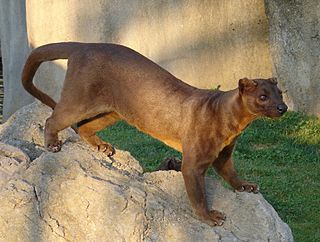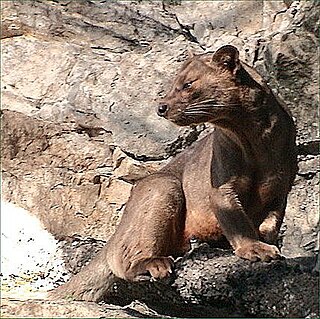 W
WEupleridae is a family of carnivorans endemic to Madagascar and comprising 10 known living species in seven genera, commonly known as euplerids, Malagasy mongooses or Malagasy carnivorans. The best known species is the fossa, in the subfamily Euplerinae. All species of Euplerinae were formerly classified as viverrids, while all species in the subfamily Galidiinae were classified as herpestids.
 W
WThe broad-striped Malagasy mongoose is a species of Galidiinae, a subfamily of mongoose-like euplerids native to Madagascar. The species contains two known subspecies: Galidictis fasciata fasciata and Galidictis fasciata striata.
 W
WThe brown-tailed mongoose, Malagasy brown-tailed mongoose, or salano is a species of mammal in the family Eupleridae. It is endemic to Madagascar. Its natural habitat is subtropical or tropical dry forests. It is threatened by habitat loss.
 W
WThe fossa is a cat-like, carnivorous mammal endemic to Madagascar. It is a member of the Eupleridae, a family of carnivorans closely related to the mongoose family Herpestidae. Its classification has been controversial because its physical traits resemble those of cats, yet other traits suggest a close relationship with viverrids. Its classification, along with that of the other Malagasy carnivores, influenced hypotheses about how many times mammalian carnivores have colonized Madagascar. With genetic studies demonstrating that the fossa and all other Malagasy carnivores are most closely related to each other forming a clade, recognized as the family Eupleridae, carnivorans are now thought to have colonized the island once, around 18 to 20 million years ago.
 W
WCryptoprocta spelea, also known as the giant fossa, is an extinct species of carnivore from Madagascar in the family Eupleridae, which is most closely related to the mongooses and includes all Malagasy carnivorans. It was first described in 1902, and in 1935 was recognized as a separate species from its closest relative, the living fossa. C. spelea is larger than the fossa, about the size of a gray wolf, but otherwise similar. The two have not always been accepted as distinct species. When and how the larger form became extinct is unknown; there is some anecdotal evidence, including reports of very large fossas, that there is more than one surviving species.
 W
WDurrell's vontsira is a Madagascan mammal in the family Eupleridae of the order Carnivora. It is most closely related to the brown-tailed mongoose, with which it forms the genus Salanoia. The two are genetically similar, but morphologically distinct, leading scientists to recognize them as separate species. After an individual was observed in 2004, the animal became known to science and S. durrelli was described as a new species in 2010. It is found only in the Lac Alaotra area.
 W
WThe Eastern falanouc is a rare mongoose-like mammal in the carnivoran family Eupleridae endemic to Madagascar.
 W
WEupleres is a genus of two species of mongoose-like euplerid mammal native to Madagascar. They are primarily terrestrial and consume mainly invertebrates.
 W
WEuplerinae, more commonly known as malagasy civets, is a subfamily of carnivorans that includes four species restricted to Madagascar. Together with the subfamily Galidiinae, which also only occurs on Madagascar, it forms the family Eupleridae. Members of this subfamily, which include the fossa, falanoucs and Malagasy civet, were placed in families like Felidae and Viverridae before genetic data indicated their consanguinity with other Madagascar carnivorans. Within the subfamily, the falanouc and Malagasy civet are more closely related to each other than to the fossa.
 W
WThe fossa is a cat-like, carnivorous mammal endemic to Madagascar. It is a member of the Eupleridae, a family of carnivorans closely related to the mongoose family Herpestidae. Its classification has been controversial because its physical traits resemble those of cats, yet other traits suggest a close relationship with viverrids. Its classification, along with that of the other Malagasy carnivores, influenced hypotheses about how many times mammalian carnivores have colonized Madagascar. With genetic studies demonstrating that the fossa and all other Malagasy carnivores are most closely related to each other forming a clade, recognized as the family Eupleridae, carnivorans are now thought to have colonized the island once, around 18 to 20 million years ago.
 W
WGalidictis is a genus in the subfamily Galidiinae of the family Eupleridae: a group of carnivorans that are endemic to Madagascar.
 W
WGalidiinae is a subfamily of carnivorans that is restricted to Madagascar and includes six species classified into four genera. Together with the three other species of indigenous Malagasy carnivorans, including the fossa, they are currently classified in the family Eupleridae within the suborder Feliformia. Galidiinae are the smallest of the Malagasy carnivorans, generally weighing about 600 to 900 g. They are agile, short-legged animals with long, bushy tails.
 W
WGrandidier's mongoose, also known as the giant-striped mongoose or Grandidier's vontsira, is a small carnivoran that lives only in a very small area of southwestern Madagascar, in areas of spiny forest vegetation. It is pale brown or grayish coloured, with eight wide, dark stripes on its back and sides. Grandidier's mongoose is larger than the related broad-striped Malagasy mongoose, G. fasciata, and its stripes are not as wide. The species is named after Alfred Grandidier.
 W
WThe Malagasy or striped civet, also known as the fanaloka or jabady, is an euplerid endemic to Madagascar.
 W
WThe narrow-striped mongoose is a member of the family Eupleridae endemic to Madagascar. It inhabits the Madagascar dry deciduous forests in western and southwestern Madagascar, where it lives from sea level to about 125 m (410 ft) between the Tsiribihina and Mangoky rivers. In Malagasy it is called bokiboky.
 W
WThe ring-tailed vontsira, locally still known as the ring-tailed mongoose is a euplerid in the subfamily Galidiinae, a carnivoran native to Madagascar.
 W
WSalanoia is a genus of euplerid carnivoran with two currently described species found in Madagascar. They are mongoose-like, which is reflected in the older versions of their English names, for example brown-tailed mongoose which is now called brown-tailed vontsira. The name Salanoia is derived from one of the vernacular names for Salanoia concolor: Salano.